HXT 42-60/06 500kv Brushless Outrunner from Untied Hobbies/Hobby City - A Review
Manufacturer's designation*: EMP C4260/06-0500
A Review by Ken Myers
Originally Published in the Nov. '07 Ampeer
Newsletter of the Electric Flyers Only of Southeastern Michigan, USA
IMPORTANT NOTE! 11/27/07 It appears that United Hobbies/Hobby City has discontinued the HXT 42-60/06 500 and replaced it with the Turnigy 42-60 500Kv 900W Outrunner for $35.95. I know NOTHING about this new motor except the fixed end of the motor is similar to the one reviewed here, but the rotating bell is different. The hardware appears to be exactly the same.
11/28/07 Ahhh. Here's a note copied from RC groups. It is from UH/HC to a member by the ID of scrapster:
Mystery solved by the second e-mail I received from UH:
"Hello.
HXT = hextronik
Hextronik is our company. We have changed the name of the motor because the factory that make this motor have complaints from UK vendors about our pricing.
We have been forced to change both the name and the shape of the end bell to help remove complaints on our pricing from western vendors.
If you are having difficulty with this, please call our office and ask to speak with the manager in charge. He will be able to speak to you at length regarding the naming and branding issues related to these products at this price.
Regards
Samee"
The direct link to the thread about this topic is here.
* Since the original publication of the this information, I have found two more Chinese "manufacturers" that claim to manufacturer these motors; Dihan Industrial Co., LTD www.dihan.cn/brushless%20motor.htm and Shenzhen Once Top Motor Manufacture Co., Ltd. www.wanzhida.cn/en/Exhibit1/index.asp.

On August 31, 2007 I ordered two HXT 42-60/06 500kv brushless outrunners from Untied Hobbies (aka Hobby City) (www.unitedhobbies.com) in Hong Kong. They were priced at $29.78USD each and shipping was $14.99USD for a total of $74.55USD or $37.28USD each. They arrived on Friday, September 7, 2007.
On the Untied Hobbies Web site, I noticed that all of the motors with the three-letter prefix HXT did not look to be of the same construction. I do not know what HXT means, but they do not all seem to be from one manufacturer.
On one end of the clear plastic box that the motor came in, I found three letters "XYH". All of the writing on the clear plastic box and one side of the instruction sheet had a "sort of" English on them.
The other end had a sticker that read, "Kv / 500 Rpm/V"
Box Side A: "Out runner brushless motor for aeromodelling OK-C4260 (3530)" and then some certification codes.
Box Side B: "Specification: Shape Size of Motor: ø42.5X60Xø5mm Weight: About 265g"
Box Side C: "Switch Your Look - It's Easy!"
Box Side D: "Note: 1 Do not put it with metals, in order to avoid damaging motor. 2 Please carefully read the instructions before using it."
At the top of the instruction sheet it says, "Ok-4260 Out Runner Brushless Motor Instruction"
Below the illustrations of the motor and wiring diagram on the instruction sheet it says, "XYH brushless motors ..."
I did an Internet search and found that XYH is the manufacturer and the letters refer to Xingyaohua in the company name ShenZhen Xingyaohua Industrial Co., Ltd. located in Shenzhen, China. (www.xyhmotor.com/en/index.asp), www.electricmodelpower.com/en/ and www.emphobby.com/index.htm
The manufacturer calls their line of motors "EMP" which is trademarked. EMP appears to stand for Electric Model Power. They offer the "C" series outrunner, "B" series inrunner, "E" series helicopter, and "A" series for cars. I could find no reference to the A series on the Web site. I also noted in the menu on the left of the Web page that they have a CDROM series.
They explain their naming convention on the index page of the site. My two identical motors are the EMP C4260/06-0500. (www.xyhmotor.com/en/Emp_ProductShow.asp?ArticleID=248)
C - outrunner
42 - approximate outside diameter in mm
60 - approximate motor length not including the shaft in mm
06 - number of turns 6
0500 - 500Kv
According to the above Web page, here are the specifications not mentioned:
Shaft: ø5mm
Weight: 280g (instruction sheet says 265g)
Power: 900 watts in
Resistance: 23 milliohms
Idle current: 4.3 amps (but gives no voltage - see my no load tests for my data)
Recommended ESC: 45A (instruction sheet says 70A)
Nickel cells: 9 - 21 (instruction sheet says 6v-18v)
Li-Po cells: 3 - 7 (instruction sheet says LiPoX3 and recommends a 12X8 prop)
The details and the photos match what United Hobbies is calling the HXT 42-60/06 500kv Brushless Outrunner. (www.unitedhobbies.com/UNITEDHOBBIES/store/uh_viewItem.asp?idProduct=5454)
My Data and Motor Tests
Motor #1, weight as arrived with 4mm connectors: 273.25g/9.6 oz.
Motor #2, weight as arrived with 4mm connectors: 274.00g/9.7 oz.
I do not use 4mm connectors, so I removed them. The original motor lead length, from where it exited the motor into the cup on the male 4mm connector, was about 60mm. The wire itself might be 14-gauge, but it is most likely smaller, and is covered by a very "rubbery" insulation. The solder from the original connectors had wicked up the wire about 15mm towards the motor. After removing the connectors from the motors' leads, the motors with lead wires weighed:
Motor #1: 263.25g/9.3 oz. /Motor #2: 264.15g/9.3 oz.
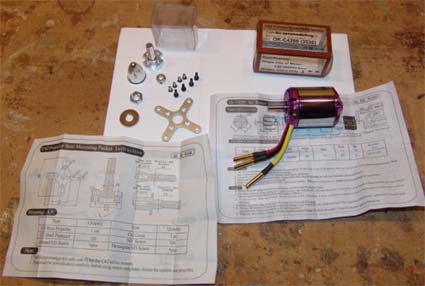
Normally I crimp to attach Anderson Power Pole (APP aka Sermos) connectors, but since the wire was already saturated with solder, I elected to solder the connectors.
Once the APP connectors were added:
Motor #1: 268.60g/9.5 oz./Motor #2: 269.30g/9.5 oz.
Motor dimensions:
Outside Diameter: 42.418mm
Outside Length: 60mm
Shaft dimensions:
Diameter: ~5mm
Length including shaft: ~80mm
| Prop Adpt. #1 | Prop Adapt. #2 |
| &quuot;+" mount: 6.65g | "+" mount: 7.65g |
| Shaft collet: 1.45g | Shaft collet: 1.40g |
| 4 Hex M3 screws: 3.45g | 4 Hex M3 screws: 3.45g |
| 4 crossed M3 screws: 1.65g | 4 crossed M3 screws: 1.70g |
| Prop adapter: 9.4g | Prop adapter: 9.2g |
| Spinner nut: 8.9g | Spinner nut: 8.9g |
| Prop Nut: 4.85g | Prop Nut: 4.80g |
| Prop washer: 2.15g | Prop washer: 2.15g |
| Total: 38.5g | Total: 39.0g |
| Grand total: 301.75g | Grand total: 303.15g |
Drill Press Test to Determine Kv
Next I used a drill press to spin the motors at 1560 RPM and measured the AC volts with my Radio Shack multimeter #20-168A. Several sets of data were collected until I settled on these values as repeatable.
Motor #1: 2.07v, 2.06v, 2.08v
Motor #2: 2.07v, 2.09v, 2.085v
The mathematical average Kv for Motor #1 is 561 RPM/v and average for Motor #2 is 558 RPM/V. The Kv appears to be 560 RPM/v, not 500 as stated by the manufacturer. The mathematical average Kt for Motor #1 is 2.41 in. oz/amp and for Motor #2 is 2.42 in. oz./amp.
Before setting up the motors for bench testing, I disassembled Motor #1 to measure the stator and take photos. I did not remove the shaft from the magnet bell, as it is a tight press fit with a single setscrew holding it in place. I did remove the setscrew to tap the shaft through just a little to make reassembling the motor with the circlip and two washers a bit easier. I used thread lock on the setscrew when I reassembled the motor. I drill press checked Motor #1 again to verify that I had reassembled it correctly.

Stator dimensions:
Diameter: 35.306mm
Length: 30.0mm
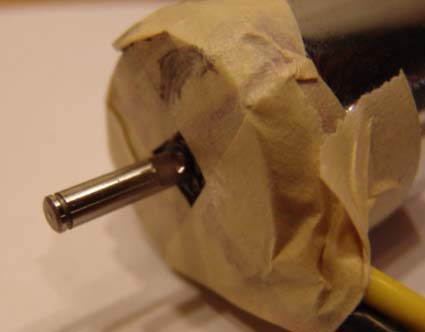
There is no "groove" in the shaft to secure the setscrew of the safety collet when using the supplied prop adapter. At first I put only a small "flat" on the shaft using my Dremel rotary tool and grinding disk. When I affixed the "+" mount to the motor, the motor would not spin freely by hand. The setscrew in the safety collet was rubbing on the hole in the mount where the shaft passes through. I then ground a grove into the shaft so that the setscrew, when tightened, was below the outside of the safety collet.
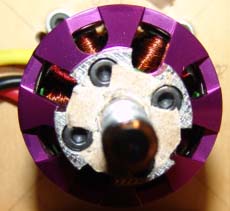
220-grit sandpaper was attached to the face of the prop adapter to aid in prop tightening without having to "physically hold" the motor. There is cross-hatching cut into the face of the prop adapter and one side of the prop washer, but they do not seem to work well at keeping the prop from slipping.
When I went to mount the "+" mount to my motor test stand, it didn't match up to any of my preexisting holes. (My bench test mount is beginning to look like a shotgun blasted it!)
A BP Hobbies BP 70A ESC was used for the testing. It was set up as follows.
Cell Type: NiMh/NiCD Auto Cell count
Throttle Setting: Auto Throttle Range
Brake Setting: No Brake
Direction and Cutoff Type: Clockwise Rotation
Timing Mode Setting: 1-deg for the first tests on each motor, 15-deg for the second
Pulse Width Modulation (PWM) Setting: 8Khz
At each timing setting, the no load tests were completed first. A strip of white paper was affixed to the rotating bell with spray adhesive on the paper only and a strip of masking tape was applied over the joint. A black magic marker was used to put a single stripe on the rotating bell to measure the RPM as the Hyperion Emeter has the ability to tach a single blade.
As always, I capture five readings and then average them to get my data to enter into the Drive Calculator (DC) computer program available FREE at www.drivecalc.de.

I measured the no load characteristics twice. Once using a 10-cell RC-1700 NiCad Pack and then again using a Skyshark 4S1P 4000mAh Li-Po. I ran each motor being tested with a different pack before the readings were taken, so that the motor was "warm" before the readings were taken.
No Load Results:
Motor #1
10-cell NiCad: 1-deg 3.46 amps, 13.074v, 6984 RPM
4S Li-Po: 1-deg 3.776 amps, 16.02v, 8640 RPM
10-cell NiCad: 15-deg 3.264 amps, 12.742v, 7020 RPM
4S Li-Po: 15-deg 3.718 amps, 15.998v, 8808 RPM
Motor #2
10-cell NiCad 1-deg 2.904 amps, 12.864v, 6948 RPM
4S Li-Po: 1-deg 3.268 amps, 16.18v, 8736 RPM
10-cell NiCad: 15-deg 3.118 amps, 13.132v, 7236 RPM
4S Li-Po: 15-deg 3.514 amps, 16.208v, 8916 RPM
How XYH derived 4.3 as the no load amp draw, I am not sure.
The Props
APC 14x8.5E, 32.90g, purchased March 2006, listed in DC as 14x8.5 APC E Wt. 33g
APC 13x9 Pattern, 62.50g, purchased unknown, listed in DC as 13x9 APC Pattern 62.5g
APC 13x8E, 27.75g, purchased June 2006, listed in DC as 13x8 APC E
APC 12x10E, 22.8g, purchased sometime in 2005, listed in DC as 12x10 APC E Wt. 23g
As I have noted before, APC changed the design of the E prop series a few years ago. There was not a 14x8.5E or 13x9 Pattern in DC, so I added them. My particular 12x10E does not match the prop power factors used in DC, so I've added my prop power factors to the DC prop list.
Battery
The same 6S1P M1 (A123 Systems) battery from BigERC.com was used to collect all prop data. Five data points were collected and recorded for each of the four props before the battery was recharged. The numbers presented here do NOT reflect the "Beginning or Top" of the pack numbers. Actually, all the 12x10E numbers, which were taken last, were about 1/2 way through the battery capacity, based on the amount of mAh returned when recharged.
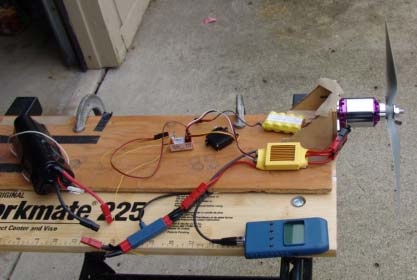 Collected Data:
Collected Data:
Ambient temperature has an affect on the outcome of any motor testing. Do not expect exactly the same results as provided here. The ambient temperature affects the prop and how it is "working" in the air and the battery. I do not have a powerful power supply to do motor testing, therefore I must rely on batteries. The battery temperature can make a difference in system performance. To see how temperature affects Emoli, Li-Poly and M1 (A123 System) cells, read my "Effects of Temperature On the Battery" article.
The elevation of Walled Lake, MI, USA is about 287m. All of the tests were done outside on a very cloudy day.
System power out is difficult to determine without using a dynamometer. While I have a spreadsheet that uses two different mathematical models to estimate system power out, for simplicity, I have chosen to present the numbers from Drive Calculator in the data below.
Motor #1 1-deg timing, Temp: ~15 deg. C, Pressure: 29.81" - rising, Humidity 73%
APC 14x8.5E, 16.576v, 35.636 amps, 7176 RPM, 590.8859 Watts in, 406 Watts out, DC Sys. Eff. 71.3%
APC 13x9 Pattern, 16.976v, 34.186 amps, 7434 RPM, 580.4996 Watts in, 400 Watts out, DC Sys. Eff. 71.7%
APC 13x8E, 17.056v, 31.382 amps, 7608 RPM, 535.45516 Watts in, 371 Watts out, DC Sys. Eff. 72.0%
APC 12x10E, 16.9v, 31.58 amps, 7512 RPM, 533.8568 Watts in, 369 Watts out, DC Sys. Eff. 71.9%
Motor #1 15-deg timing, Temp: ~18 deg. C, Pressure: 29.80" - rising, Humidity 55%
APC 14x8.5E, 16.665v, 36.625 amps, 7267.5 RPM, 610.50355 watts in, 424 Watts out, DC Sys. Eff. 70.1%
APC 13x9 Pattern, 16.94v, 34.966 amps, 7488 RPM, 592.42464 watts in, 414 watts out, DC Sys. Eff. 70.8%
APC 13x8E, 17.076v, 32.522 amps, 7674 RPM, 555.51192 watts in, 391 watts out, DC Sys. Eff. 71.1%
APC 12x10E, 16.808v, 32.58 amps, 7554 RPM, 547.779 watts in, 386 watts out, DC Sys. Eff. 71.1%
Motor #2 1-deg timing, Temp: ~19 deg. C, Pressure: 29.72" - steady, Humidity 48%
APC 14x8.5E, 16.988v, 37.152 amps, 7392 RPM, 631.26346 watts in, 447 Watts out, Sys. Eff. 72.6%
APC 13x9 Pattern, 17.194v, 34.664 amps, 7602 RPM, 596.11986 watts in, 425 watts out, Sys. Eff. 73.1%
APC 13x8E, 17.298v, 32.174 amps, 7758 RPM, 556.63566 watts in, 399 watts out, Sys. Eff. 73.5%
APC 12x10E, 17.084v, 32.3 amps, 7656 RPM, 551.94206 watts in, 395 Watts out, Sys. Eff. 73.4%
Motor #2 15-deg timing, Temp: ~20 deg. C, Pressure: 29.72" - falling, Humidity 45%
APC 14x8.5E, 16.788v, 37.4 amps, 7398 RPM, 628.1104 watts in, 448 watts out, Sys. Eff. 71.9%
APC 13x9 Pattern, 16.97v, 35.34 amps, 7596 RPM, 599.88556 watts in, 431 Watts out, Sys. Eff. 72.2%
APC 13x8E, 17.134v, 32.862 amps, 7794 RPM, 563.16156 watts in, 407 Watts out, Sys. Eff. 72.6%
APC 12x10E, 17.00v, 33.464 amps, 7704 RPM, 569.03998 watts in, 411 Watts out, Sys. Eff. 72.5%
I verified all the data to see that it compared well with the data I had input into DC and found that it was quite accurate.
Next I created an "average" motor using the data. The "average" data was uploaded to DC. That is the reason I listed the motor data for each example here.
I also uploaded the motor to DC with the manufacturer's naming convention, as it is available under that name as well.
DC now contains the data to make some reasonably accurate predictions using various battery combinations and props with this motor.
Top of the Pack Numbers
The following data was collected with a fully charged pack using the Hyperion Emeter.
The numbers that are entered after "DC" are the Drive Calculator generated numbers for comparison.
Measured: Motor #1 APC 13x9 pattern, 17.34v, 35.9 amps, 7590 RPM, 623 watts in
DC: Motor #1 APC 13x9 pattern, 17.34v, 34.3 amps, 7601 RPM, 595 watts in
Measured Motor #2 APC 12.5x10 pattern, 17.98v, 36.0 amps, 7950 RPM, 647 watts in
DC: Motor #2 APC 12.5x10 pattern, 17.98v, 34.5amps, 7966 RPM, 621 watts in
Flying the Motor
The first flight test using Motor #1 was on Saturday, October 6. The motor was mounted to the Flite 40. The cowl was modified to become the front of the fuselage and epoxied onto the airframe. The original 1/8" balsa cowl front was replaced with 1/8" plywood "front firewall", so that the motor could be mounted directly to the new front plate. In this configuration, the prop adapter that came with the motor was not used. A BP Hobbies' F459 Aluminum/Steel Prop Adapter Union Type - 5.0mm was used to mount the APC 13x9 pattern prop.
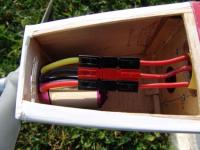
The Flite 40 took off easily from the grass at only partial throttle. The first few minutes were spent resetting the trims of the plane. (The plane had a problem not related to the motor and was out of trim quite a bit.) The throttle was being used to fly the plane at various speeds while re-trimming. About three minutes into the flight there was a catastrophic motor mount failure. When the 10 ounces of motor and prop parted company with the plane, the CG changed drastically. I was able to land the plane almost on the runway with very little damage to the airframe. The 1/8" plywood firewall and part of the motor were all that were found.
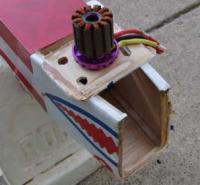
The mounted failed because the 1/8" plywood could not handle the over 600 watts in and the plywood laminate separated leaving the epoxy glue behind. Lesson learned, use a metal mount for this type of mounting with this much power!
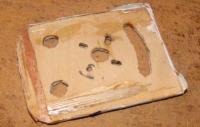
Motor #2 was mounted to the firewall using the "+" mount.
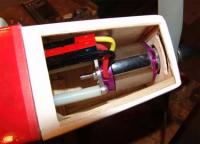
Sunday, October 14 was a total success with Motor #2. An APC 12.5x10 pattern prop was used for three test flights. The first flight was a 3-minute trimming flight. During the trimming flight, it was apparent that even though the power system using the HXT 42-60/06 was not as efficient as the original TowerPro 3520-7 using an APC 12x7 pattern prop as reported last month, it was flying "better." The speed was up and so were the vertical climbs and loop size. The second flight was timed for 5 minutes. During that flight I did as much as I could without holding back. The 6S M1 pack was then filled at the field and it took about 1700mAh. The timer on my Hitec Eclipse 7 was reset for 6 minutes. Once again the third flight was pretty aggressive and included a landing and taxi back to the pilot.
When I recharged the pack a few days later, it took 1831mAh. It looks like 7 minute flights should be possible.
When the cowl was turned back into a cowl and recovered, the shark's teeth had to go. A friend of mine, Jim Cross, said it is unlucky to have them on this type of plane. Man, was he right! :-)
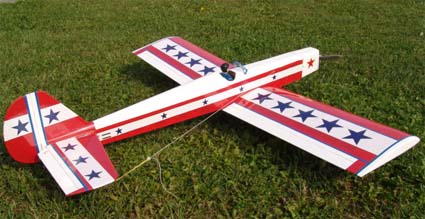
Conclusions and Observations:
The motor with leads has a weight of about 264g, not the 280g listed on the United Hobbies/Hobby City and XYH Web sites. It does have about that weight if the 4mm connectors are included. While the manufacturer suggests 900 watts in as the maximum, I personally would not use this motor at more than 800 watts in. My preferred use will be in the 500 watts in to 650 watts in range.
The motor has quite a high Io. It appears not to be very efficient, but efficient enough to be usable. Both my calculations and the DC calculations indicate that the best system efficiency, when using this motor, is below 75% and even drops below 70% at times. The Rm appears to be quite high as well, since the motor got quite warm after only a few seconds of motor run time with the prop on during the static testing. The user is strongly advised to follow the advice on the instruction sheet, "Motors must be using with good ventilation, which is easy to emanate heat."
The prop shaft has to have a "groove" added to secure the safety collet.
The equivalent AXI designation would be a 3530/06, if it existed.
The mathematical measured Kv appears to be about 560 RPM/V. At 1-deg timing advance it has an apparent Kv of 560 RPM/V according to the computed Kt in DC. With 15 degrees of timing advance the apparent Kv is 565 RPM/V based on the DC computed Kt. As far as I am concerned, the Kv is 560, not the stated 500.
There was a very strange note in the instructions. It says, "Battery/Prop LiPoX3/12x8". I used DC and tried a good 3S Li-Po pack to get maximum voltage and with all of the 12x8 props listed, the amp draw was between 13 and 16 amps. In my opinion, that is way under utilizing this motor.
DC possible uses for this motor in sport and sport scale plane with 1-deg ESC timing and M1 Cells
Note: For specific weight and wing area recommendations see the tables at www.theampeer.org/M1-outrunners/M1-outrunners.htm
5S APC 13x10 sport, 14.66v, 34.1 amps, 6408 RPM, eff. 72%, (pitch speed 61 mph)
5S APC 14x10E, 14.50v, 37.1 amps, 6216 RPM, eff. 72%, (pitch speed 59 mph)
6S APC 12x10E, 17.61v, 33.8 amps, 7788 RPM, eff. 73%, (pitch speed 74 mph)
6S APC 12.5x10 pattern, 17.63v, 33.4 amps, 7813 RPM, eff. 72.5%, (pitch speed 74 mph)
6S APC 13x8 sport, 17.61v, 33.9 amps, 7781 RPM, eff. 73%, (pitch speed 59 mph)
6S APC 13x9 pattern, 17.54v, 34.9 amps, 7699 RPM, eff. 72%, (pitch speed 66 mph)
6S APC 14x7E, 17.44v, 36.4 amps, 7587 RPM, eff. 72%, (pitch speed 50 mph)
6S APC 14x8.5E, 17.36v, 37.6 amps, 7499 RPM, eff. 72%, (pitch speed 60 mph)
7S APC 13x6.5E, 20.32v, 36.8 amps, 8881 RPM, eff. 72%, (pitch speed 55 mph)
7S APC 13x7 sport, 20.30v, 37.1 amps, 8860 RPM, eff. 72%, (pitch speed 59 mph)
My Final Thoughts
I purchased this motor so that I could use a larger diameter prop on the Flite 40 from Dymond RC, but I wanted to keep the static wide open throttle (WOT) amps to about 35.
It appears to have been a relatively good choice. Even though I'm losing about 50 watts out compared to the TowerPro 3520-7 using an APC 12x7 pattern prop, the larger diameter props (12.5x10 & 13x9), with there better efficiency appear to have more than made up for the added electrical and mechanical losses.
Kv
Kv is a motor constant and is directly related to Kt, the motor torque constant. Kv is most often expressed as RPM/Volt or RPM/v. Kt is often expressed in the units inch ounces per amp. Kv (expressed as RPM/v) * Kt = 1352.4. The Kv motor constant has nothing to do with the applied voltage. It is part of the motor's physical makeup.
Kv is also known as the generator constant or dynamo constant. When any electric motor is spun physically it generates electricty. It doesn't matter whether it is a brushed or brushless motor.
A typical hobby brushed motor can be spun by a drill press at a constant speed. By measuring the DC voltage across the terminals, with brushes set to neutral timing, and knowing the RPM of the drill press the Kv can be calculated. i.e. 1560 RPM / 1.6v DC measured volts = 975 RPM per volt.
A brushless motor isn't quite as simple to do, but can be done using some math. A brushless motor has three possible lead combinations that need to be measured using AC voltage. i.e. Know the RPM (1560 in this example). Measure the AC voltage on each pair of leads, there are three possible combinations with a brushless motor. Lead combination A - 2.08, Lead combination B - 2.08, Lead combination C - 2.08. Note that most cheap motors do not have all three combinations come out exactly the same, but they do on the better quality motors. Use the average of the three voltage numbers if the measurements are slightly different.
Find the V-peak by multiplying the average AC volts by 1.414 In this example 2.08 * 1.414 = 2.94v
Divide 1000 (a constant) by the RPM (1560 in this case) = 0.64
Ke = V-peak ((2.94) * (in this case 0.64))/1000 = 0.00188
Find the inverse of Ke (1/Ke) (1/0.00188 in this case) = 531
Divide the inverse of Ke by 0.95 = 559 RPM/v or the approximate Kv expressed as RPM/v
It should be noted that many manufacturers/suppliers, even the good ones, provide inaccurate information on the motor's Kv, so if you can, measure it to be sure you have the motor you want. Nothing really needs to be done to the motor to measure the Kv, so it should be easily returnable if the Kv is not suitable, as the shaft will only have been chucked into a drill press that is set up with a known RPM.
Advancing the timing on a brushed motor (using rotation of the brushes) or brushless motor (via an ESC setting) changes the apparent Kv, increases the RPM and Io (no load amp draw), increases the heat (wasted energy) more than neutral timing, but increases the power out.
Return to article
Timing
Advancing the timing has an affect on the motor output. To find out more about advancing the timing, read the timing article.
Return to article
To Reach Ken Myers, you can land mail to the address at the top of the page. My E-mail
address is:
KMyersEFO@theampeer.org
EFO WEBsite:
|











